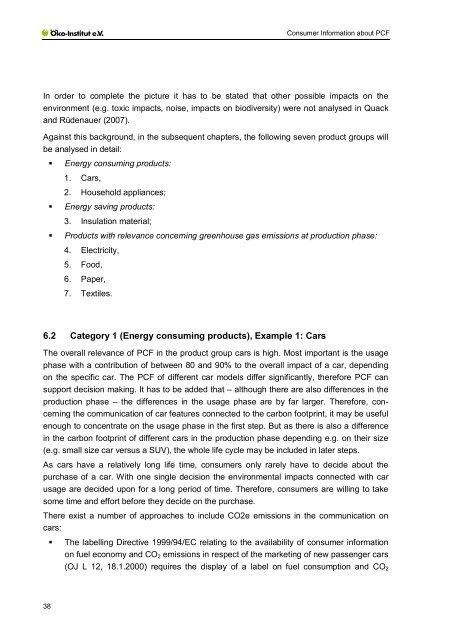Requirements on Consumer Information about Product ... - ANEC
Requirements on Consumer Information about Product ... - ANEC
Requirements on Consumer Information about Product ... - ANEC
You also want an ePaper? Increase the reach of your titles
YUMPU automatically turns print PDFs into web optimized ePapers that Google loves.
C<strong>on</strong>sumer Informati<strong>on</strong> <strong>about</strong> PCF<br />
In order to complete the picture it has to be stated that other possible impacts <strong>on</strong> the<br />
envir<strong>on</strong>ment (e.g. toxic impacts, noise, impacts <strong>on</strong> biodiversity) were not analysed in Quack<br />
and Rüdenauer (2007).<br />
Against this background, in the subsequent chapters, the following seven product groups will<br />
be analysed in detail:<br />
• Energy c<strong>on</strong>suming products:<br />
1. Cars,<br />
2. Household appliances;<br />
• Energy saving products:<br />
3. Insulati<strong>on</strong> material;<br />
• <strong>Product</strong>s with relevance c<strong>on</strong>cerning greenhouse gas emissi<strong>on</strong>s at producti<strong>on</strong> phase:<br />
4. Electricity,<br />
5. Food,<br />
6. Paper,<br />
7. Textiles.<br />
6.2 Category 1 (Energy c<strong>on</strong>suming products), Example 1: Cars<br />
The overall relevance of PCF in the product group cars is high. Most important is the usage<br />
phase with a c<strong>on</strong>tributi<strong>on</strong> of between 80 and 90% to the overall impact of a car, depending<br />
<strong>on</strong> the specific car. The PCF of different car models differ significantly, therefore PCF can<br />
support decisi<strong>on</strong> making. It has to be added that – although there are also differences in the<br />
producti<strong>on</strong> phase – the differences in the usage phase are by far larger. Therefore, c<strong>on</strong>cerning<br />
the communicati<strong>on</strong> of car features c<strong>on</strong>nected to the carb<strong>on</strong> footprint, it may be useful<br />
enough to c<strong>on</strong>centrate <strong>on</strong> the usage phase in the first step. But as there is also a difference<br />
in the carb<strong>on</strong> footprint of different cars in the producti<strong>on</strong> phase depending e.g. <strong>on</strong> their size<br />
(e.g. small size car versus a SUV), the whole life cycle may be included in later steps.<br />
As cars have a relatively l<strong>on</strong>g life time, c<strong>on</strong>sumers <strong>on</strong>ly rarely have to decide <strong>about</strong> the<br />
purchase of a car. With <strong>on</strong>e single decisi<strong>on</strong> the envir<strong>on</strong>mental impacts c<strong>on</strong>nected with car<br />
usage are decided up<strong>on</strong> for a l<strong>on</strong>g period of time. Therefore, c<strong>on</strong>sumers are willing to take<br />
some time and effort before they decide <strong>on</strong> the purchase.<br />
There exist a number of approaches to include CO2e emissi<strong>on</strong>s in the communicati<strong>on</strong> <strong>on</strong><br />
cars:<br />
• The labelling Directive 1999/94/EC relating to the availability of c<strong>on</strong>sumer informati<strong>on</strong><br />
<strong>on</strong> fuel ec<strong>on</strong>omy and CO 2 emissi<strong>on</strong>s in respect of the marketing of new passenger cars<br />
(OJ L 12, 18.1.2000) requires the display of a label <strong>on</strong> fuel c<strong>on</strong>sumpti<strong>on</strong> and CO 2<br />
38
















